24th October 2007
 Tuesday, November 20, 2007 at 07:43PM
Tuesday, November 20, 2007 at 07:43PM The tracks in the sand below the house read like an inventory of who’s been visiting during the night. This morning I took the camera down onto the beach to see what I could discover. As usual, there were a myriad of tracks, criss-crossing the sand and the mud flats down to the river. I even found the monitor lizard tracks, left behind from yesterday. Of course there were many hippo tracks, to-ing and fro-ing across the sand, bearing witness to the noises I heard last night. It’s fun to see how, even at the river’s edge where the water is shallow and calm, you can see evidence of bird traffic – storks, plovers, geese, you name it – under the water on the riverbed itself. In the mud close to the river, the tracks of the animals are quite clear and well defined, then – as you would expect – as you get into the dry sand further from the river, the tracks are less clear, and disintegrate more quickly as the wind starts to obliterate them. There are other tell-tale signs of creatures recently passed by, if you remember to look out for them – the porcupine quills left outside our front door bear testament to his coming by last night to gnaw at the cabbage leaves I left out for him. The droppings of impala, and dik-dik – some fresh telling us they were here a few hours ago, others a day or two old. Hippo dung too, and a few unidentifiable droppings which look like they came from some cat or other. A stray guinea fowl feather tells of a flock passing through, not too long ago, otherwise the breeze would have carried it away by now.
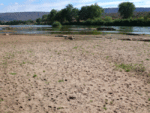
Track Stories...
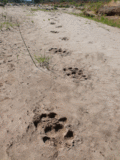
Hippo Trail...
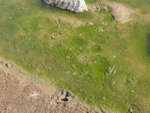
Bird prints at river's edge...
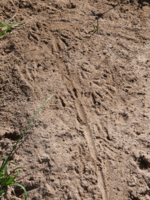
Monitor Lizard tracks...
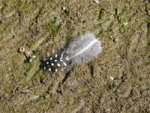
Guineafowl feather...
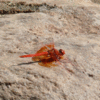 The red dragonflies we get here are incredible so, while I was down at the river’s edge, I thought they were worth a couple of photos.
The red dragonflies we get here are incredible so, while I was down at the river’s edge, I thought they were worth a couple of photos.
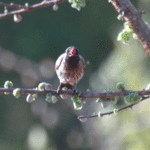
Bulbul with a mouthful
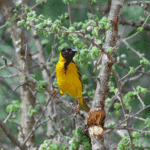
Village (aka Black-headed) Weaver
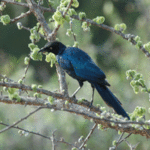
Long-tailed Glossy Starling
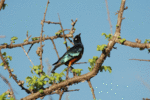
Superb Starling
When I first got up, I could hear a lot of bird activity in the commiphora tree to the right of our bedroom, on the hippo-lawn-to-be, notably the cheerful trill of the bulbuls. Sure enough, the tree is full of fruit and the birds were there, feasting. They were breaking open the green skinned berries and devouring the red fruit inside with relish. I photographed the many Yellow Vented Bulbuls (there must have been fifteen in the tree), as well as Glossy Starlings and Superb Starlings too, Village / Black Headed Weavers, even the Fork Tailed Drongo.
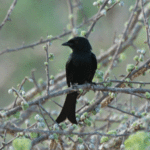
Fork-tailed Drongo
It’s funny how birds have recognisable characteristics – some are bullies (the Starlings and the Drongo, for example, are always trying to chase other birds away) and then you have other birds, which seem to have a much gentler disposition, like the Bulbuls – or maybe I’m just imagining this. Either way, the Starlings - and the Spur-winged Plovers too - are always acting like bullies, trying to chase the other birds away. The Sparrows are pretty nasty too – they even pull other baby birds out of their nests, in order to lay eggs in it themselves.
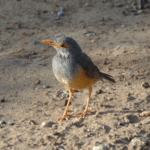
Olive Thrush
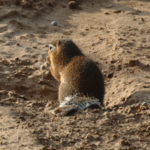
Ground Squirrel
An Olive Thrush was hopping around on the ground under the commiphora tree too, though I’m sure he was in search of insects not fruit, and the ground squirrels were there too, picking up berries knocked to the ground by the foraging birds.
There was also a feeding frenzy going on around the bird food I had put out, including a couple of tree squirrels, who are smaller than the ground squirrels, and rush around with quick jerky movements, in and out of the trees, and never staying still for long. I chased one out of the house today – they are so destructive once they get into your things, shredding blankets and chewing through plastic, you name it.
Talking of “invaders”, the Little Swifts are trying to build their nests in the eaves above our bath – we are trying to discourage them, as they will make such a mess…but what to do, when we have built a house, right in the middle of their own stomping ground? They just think the house is a strategically placed rock ledge, with lots of perfect nooks and crannies for nest building.
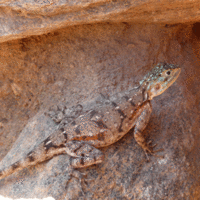
Female Agama (click to enlarge)
Later on, as I was making lunch, I noticed a female Agama Lizard on the rocks outside the kitchen (on the ramp leading up to our front door) so I nipped out with the camera to take a few shots of her, which contrast nicely with the shots of the male lizard, which I took yesterday. The female, as you can see, is not nearly as spectacularly coloured as the male, but she nonetheless has a subtle beauty with her more subdued colouration – earthy colours as opposed to ostentatious ones. Earlier, I had also taken a couple of photos of a young Agama male, showing his duller colouration, which eventually will develop into the full bright colouring of the mature adult.
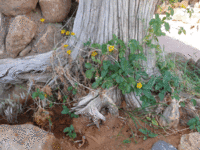
Yellow Beauies on Balcony
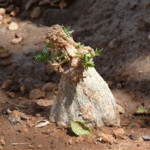
Yellow "Beauties" outside
In the gardens – or flowerbeds if you prefer – which we have planted in and around the house, on our balcony and outside our bedrooms (all on the first floor), there is this creeper which has self-seeded and seems to grow in great abundance, as it is springing up everywhere. It grows from strange melon-like bulbs in the ground, and has short-lived and pretty sun-yellow flowers. In the house, the creepers are truly thriving, as there are no antelope to prune the new shoots every time they send out a fresh set of green leaves – outside, under the commiphora tree on the hippo-lawn-to-be, there are a collection of the same melon-like bulbs, but you can see from my photos how the dik-diks have nibbled away at all their new green shoots, not giving the plants a chance to grow at all. Once the rain comes, the dik-diks will have so much greenery to choose from, they will probably leave the creepers in peace to finally clamber up the tree and flower. The grass on the Hippo Lawn is attempting to sprout too, but our watering alone will not be enough to really sustain it – it needs the rain. (My Hippo Lawn photos may seem dull now, but will be fun for comparison once the Hippo Lawn does grass over completely.)

Click to enlarge
The Martial Eagle is hanging around again today – the adult male, I think, as he is slightly smaller than the eagle I photographed two weeks ago, on the dik-dik kill. The female birds always seem to be larger - not that the male would not be equally capable of felling a dik-dik too.
2.15pm – Just now, as I was sitting working on our Five Year Plan for the Foundation, I saw a Fish Eagle land on the river’s edge just below the house. I grabbed my camera, thinking I could get some nice shots of him, without having any inkling of the drama about to unfold. At that point, I had not even noticed the small crocodile lying right below the eagle in the water. It was not until I looked through the long lens that I saw the crocodile, and the story started to unfold... The fish eagle had obviously noticed the crocodile eating a fish and decided that it was his to steal. After a lot of cautious sideways glances at the crocodile, and after a couple of “practice runs” where the eagle took off and swooped low over the crocodile to try to intimidate it – much to the latter’s chagrin, as could be seen by his fierce reaction – the eagle finally managed to drive the crocodile away, and dive down to steal the fish, which looked like a half-eaten Barbus. Fish in talons, the eagle landed for a brief moment on a nearby sandbar, perhaps to get a better hold on it, before taking off and racing away with his ill-gotten gains, to eat in peace further upstream. You can’t deny it, there’s a story to be had every single day by this river in Africa…
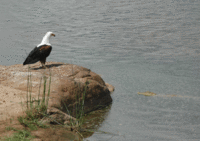
Fish Eagle observes crocodile in water below (click to enlarge image)
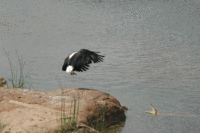
Intimidatory (or experimental?) fly-past
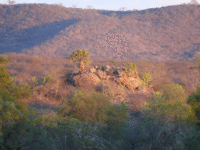
Pink Yatta & Euphorbia Kopje in evening light
9pm - Every evening, the setting sun bathes the Yatta Plateau – the long lava flow ridge on the other side of the river from us – in a soft pink glow. I tried to capture this gorgeous light in a couple of photos of what I call the “Euphorbia Kopje”, which we can see from our balcony, to the right and downstream from the house. This is a beautiful rocky little hillock, with fabulous stands of Euphorbia – one day, our own Euphorbia trees, which we planted alongside our new baobabs, may even grow to that size.
I’ve just had a luxurious shower in our bathroom that faces onto the river. The wind is so strong tonight that it was blowing the water sideways in the shower. What a lovely view out from the shower though – the moon is getting bigger and bigger, casting heavy shadows from the trees out across the river. I heard elephants - on the other bank, I think; even though the moon is so bright, I could not locate them. I guess the full moon must be in about two or three days’ time. Because we are so close to the Equator, which runs right through the middle of Kenya, a few hundred miles to the north of us, when it is full, the moon rises at exactly the same time that the sun sets. The full moon often heralds a change in the weather – let us hope that this time is no exception, as we still have not had any rain. The heat just gets more and more intense by the day. Even the storm clouds, which a few days ago were goading us then passing us by to fall elsewhere, have vanished from the skies. The river is terribly low too, an indication that there has been no rain upstream either.
Now lying in bed, with all sides of the room wide open to the wild night, I can hear the Dikkops whistling down on the river – they’re fully awake now that night has fallen; I can hear the wind rushing violently through the trees with every sudden gust, and the scratching against the house of the “eyebrows” – the palm-thatched shades above our windows – and the endless soothing tumble of the river, passing through the rapids below the house. What else can I hear? Further away, every now and then, the short gentle trill of the Scops Owl, and a little closer, the unobtrusive drone of frogs and crickets. But most of all, I think, the sound of this night belongs to the wind…
Discover more paw prints and other footprints in the sand in my Track Stories gallery...
See more red dragonfly images, alongside other amazing-looking insects...
Explore Kulafumbi's varied birdlife, including those involved in the feeding frenzy on the Commiphora this morning...
More photos of Kulafumbi's "small fry": the smaller creatures that inhabit the property, from lizards to squirrels, and more...
See the entire Photo Story of the Fish Eagle stealing the crocodile's fish...
See more Lay of the Land shots, illustrating the changing faces of Kulafumbi through the seasons...






Reader Comments